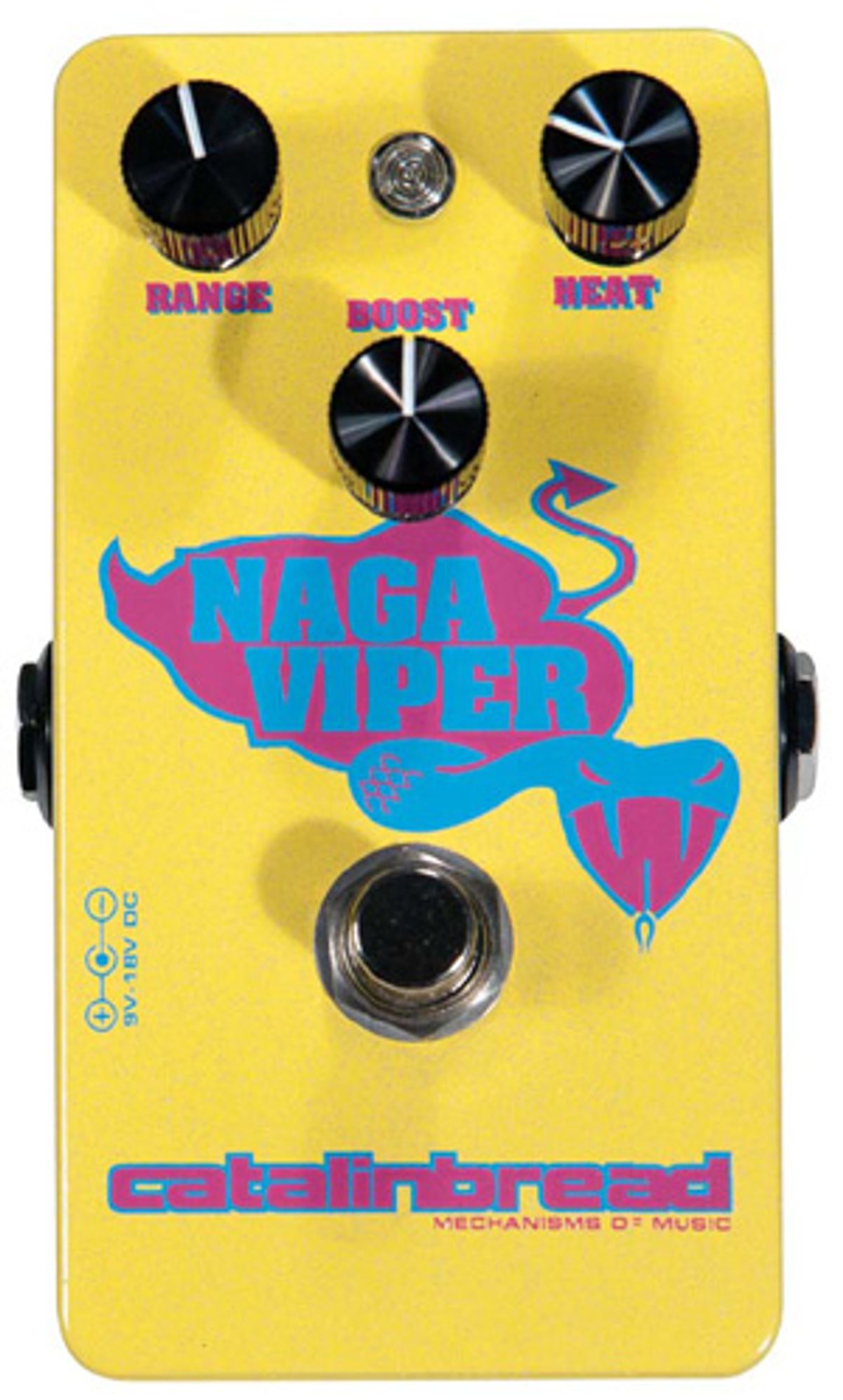
Catalinbread uses the Rangemaster as square one for the design of the Naga Viper—a treble boost with a little something extra.
Never as extroverted as say, the Fuzz
Face, the Dallas Rangemaster has
always been the retiring and modest wallflower
of classic pedals. But that doesn’t
mean its impact—or voice—has been
anything less than huge. Its contribution
to the cutting tones of players like Brian
May and Rory Gallagher is undeniable.
And Catalinbread uses the Rangemaster
as square one for the design of the Naga
Viper—a treble boost with a little something
extra.
Deceptively Simple
A tube amp on the verge of overdriving itself is the ideal setting for any boost pedal. In this environment, clean boosts can do a great job of bumping an amp into overdrive territory for a solo or heavy rhythm part, though they can also muddy the low end. A Rangemaster-style treble boost produces a less spongy, muddy overdrive in the amplifier, making it a great tool for creating cutting tones and pushing your signal to the front of the mix.
Like the Dallas Rangemaster (and most boost pedals, for that matter), the Catalinbread Naga Viper is dead simple. There’s a bypass footswitch and Boost, Range, and Heat controls, all in a bright, custard-yellow stompbox that’s tough to miss on your pedalboard.
Treble Rebel
With my Gibson SG connected to the Naga Viper and a Fender Bassman, and all the pedal’s controls at noon, my first impression was a significant decrease in low end. By lowering the Range control, however, I was able to open up the low end without changing the high-frequency response. Even with the Range at its lowest setting, the Naga Viper still cuts some of the low frequencies, evoking the sound of a clean JCM800 Marshall.
With the Boost control dimed, the Naga Viper delivers roughly 10 dB of gain—plenty for sending a Bassman into a biting, articulate overdrive. But using the Heat control, you can shape the boosted signal even further. The Heat control is essentially an internal gain circuit, and while it produces no additional dB increase in the output, it creates the perception of a much louder, hotter signal. As the Heat control is increased, the signal becomes noisier and more compressed (which is pretty common for this type of effect), but it also adds presence and articulation to note attacks. And at its highest settings, it introduces a pleasing, hissy distortion. Like the Range control, the Heat function has a way of making a 6L6 or 6V6 amp sound a lot like a Marshall—that’s pretty cool for such a simple pedal.
The Verdict
With most boosters, you’re not going to get a lot of additional tonal versatility from the unit itself. Yet with the Naga Viper, Catalinbread gives treble-boost fans a few extra shades of color to work with. If you’re a veteran treble-boost user, it’s a great way to expand on the sonic territory you already know. But for first-time treble-boost users in particular, the Naga Viper offers a rewarding introduction to the immense possibilities of boost.
Deceptively Simple
A tube amp on the verge of overdriving itself is the ideal setting for any boost pedal. In this environment, clean boosts can do a great job of bumping an amp into overdrive territory for a solo or heavy rhythm part, though they can also muddy the low end. A Rangemaster-style treble boost produces a less spongy, muddy overdrive in the amplifier, making it a great tool for creating cutting tones and pushing your signal to the front of the mix.
Like the Dallas Rangemaster (and most boost pedals, for that matter), the Catalinbread Naga Viper is dead simple. There’s a bypass footswitch and Boost, Range, and Heat controls, all in a bright, custard-yellow stompbox that’s tough to miss on your pedalboard.
Treble Rebel
With my Gibson SG connected to the Naga Viper and a Fender Bassman, and all the pedal’s controls at noon, my first impression was a significant decrease in low end. By lowering the Range control, however, I was able to open up the low end without changing the high-frequency response. Even with the Range at its lowest setting, the Naga Viper still cuts some of the low frequencies, evoking the sound of a clean JCM800 Marshall.
With the Boost control dimed, the Naga Viper delivers roughly 10 dB of gain—plenty for sending a Bassman into a biting, articulate overdrive. But using the Heat control, you can shape the boosted signal even further. The Heat control is essentially an internal gain circuit, and while it produces no additional dB increase in the output, it creates the perception of a much louder, hotter signal. As the Heat control is increased, the signal becomes noisier and more compressed (which is pretty common for this type of effect), but it also adds presence and articulation to note attacks. And at its highest settings, it introduces a pleasing, hissy distortion. Like the Range control, the Heat function has a way of making a 6L6 or 6V6 amp sound a lot like a Marshall—that’s pretty cool for such a simple pedal.
The Verdict
With most boosters, you’re not going to get a lot of additional tonal versatility from the unit itself. Yet with the Naga Viper, Catalinbread gives treble-boost fans a few extra shades of color to work with. If you’re a veteran treble-boost user, it’s a great way to expand on the sonic territory you already know. But for first-time treble-boost users in particular, the Naga Viper offers a rewarding introduction to the immense possibilities of boost.
Buy if...
you’re looking for a versatile boost that evokes the seminal Rangemaster, but adds a little more color and grit.
Skip if...
you’re already sufficiently boosted.
Rating...
Street $169 - Catalinbread - catalinbread.com |
| <<< Previous Review: Celestial Effects Virgo Overdrive | Next Review: Empress Effects Compressor >>> |

